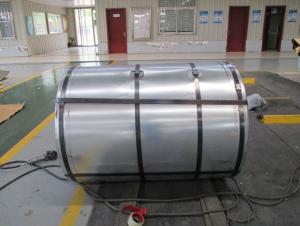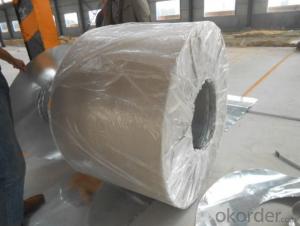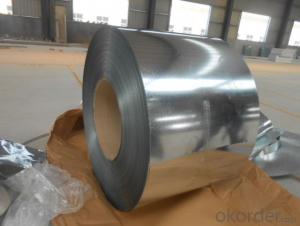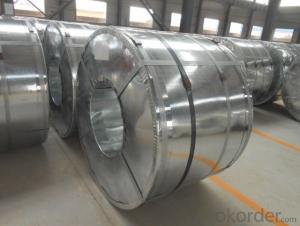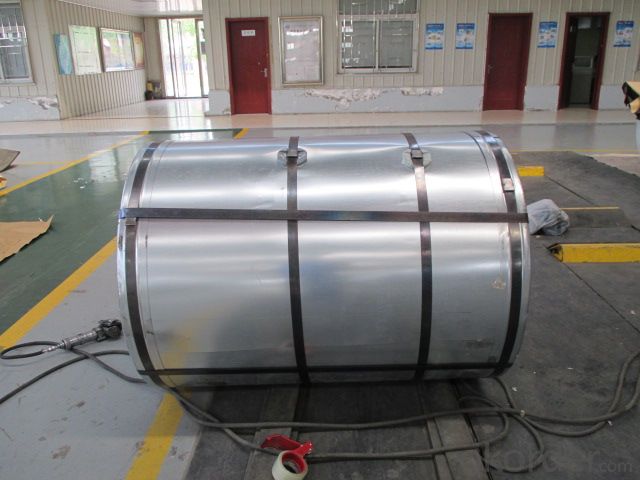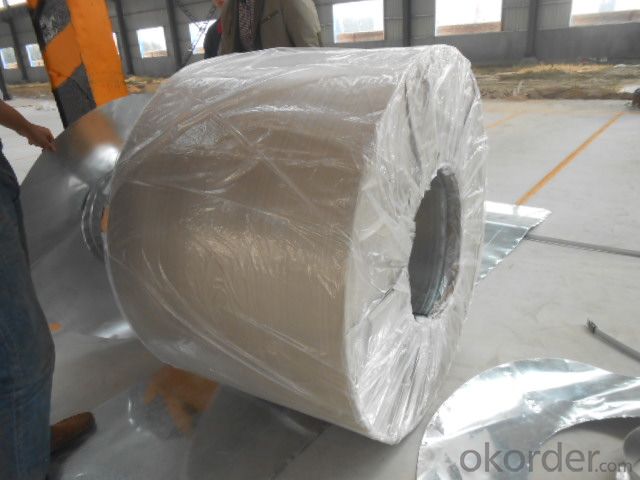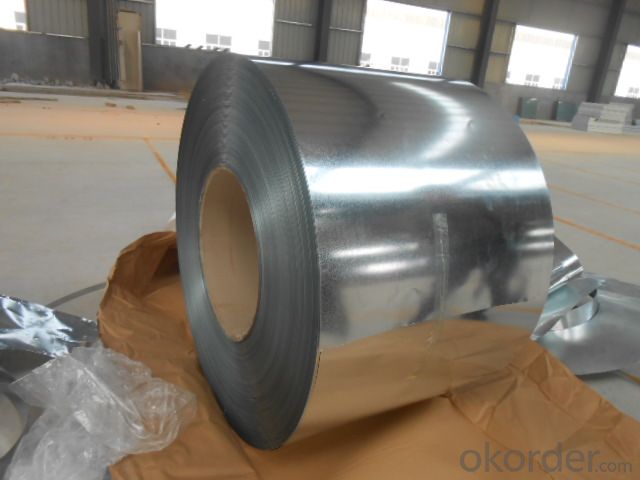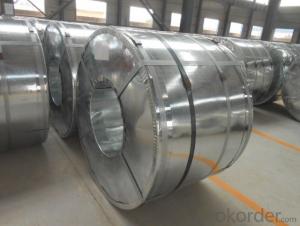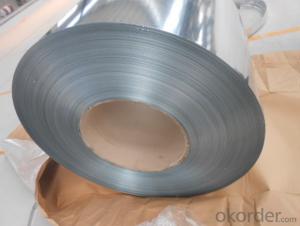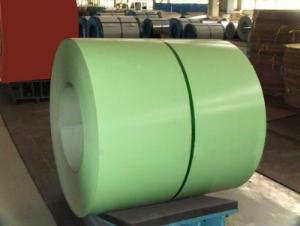PRIME GALVANIZED STEEL COIL JIS G 3302 SGCC WITH ZINC COATIONG Z06
- Loading Port:
- China main port
- Payment Terms:
- TT OR LC
- Min Order Qty:
- 25 m.t.
- Supply Capability:
- 10000 m.t./month
OKorder Service Pledge
OKorder Financial Service
You Might Also Like
Prime Galvanized steel coil
Packaging & Delivery
Packaging Detail: seaworthy export package
Delivery Detail: on request
Specifications
1. more than 10 years’ experience on this field
2. advanced equipments
3. competitive price
4. soonest delivery
Product Description :
Commodity
Hot dip galvanized steel coil
Technical Standard: JIS 3302 / ASTM A653 / EN10143/ GB/T 2518
Grade:DX51D/ S250,280,320GD,SGCC,SGHC,SGH340,SGH400,SGH440,G450,G550
Types:Commercial / Drawing / Deep Drawing / Structural quality
Width: 900mm/1000mm/1219mm/1200mm/1220mm/1250mm
Thickness: 0.2mm~4.0mm
Type of coating: galvanized
Zinc coating: Z40-275g/m2,Z40-Z450g/m2
Surface treatment: zero spangle / regular spangle/ big spangle
ID coil: 508mm or 610mm
Coil weight: 3-10/MT per coil
Package: Properly packed for ocean freight exportation in 20''container
Application:: home appliances, constructions, building, machineries
Our Advantages :
1. Expertise:
More than 10 years of manufacture: we know how to properly handle every step of production.
2. Competitive price:
We can offer competitive prices to our customers.
3. Accuracy:
We have excellent technicians and leaders, which can ensure our products are exactly what you want.
4. Materials:
All galvanized steel coils are made of high-quality raw materials.
5. Certificate:
Our products are certified by ISO9001.
6. Productivity:
We have large-scales of production lines,, which can guarantee all your orders will be finished in earliest time.
Hr CGL Technical Process:
Coil loading-> uncoiling-> cutting-> welding-> entry accumulator-> Heating and deoxidization-> galvanizing-> air cooling->water quenching-> air dryer-> tension leveler-> Passivation->air dryer->exit accumulator-> oiling-> cutting-> recoiling->coil unloading-> packing
The furnace heating style: improved Sendzimir heating technology
Hourly output: max.76.3t/h
Process after coating: tension leveling, Passivation or oiling
Our Service
Our quality
Test Equipments of Prepainted Galvanized Steel Coil : Salt-spray tester; Atomic absorption spectrophotometer; Rockwell typer hardness tester; Tensile test machine; Metrohm titration; Laboratory Bend test machine.
Our packing
Properly packed for ocean freight exportation in 20''container, galvanized metal fluted rings on inner and outer edges, galvanized metal & waterproof paper wall protection disk, galvanized metal & waterproof paper around circumference.
R&D department
R&D department concentrates on researching and developing reliable products with best quality. The quality department test and control every process of production to guarantee the best quality of products
- Q: Can steel coils be stored vertically?
- Yes, steel coils can be stored vertically.
- Q: You have two steel wool pads,one is cut up into little pieces, and the other is whole, and they are both submerged in water. 1.Which steel wool pad will rust quicker?2.How much faster will that pad rust? (estimate+explain the estimate)6.How could you make the steel wool pad rust faster?Please dont tell me to do my homework because I tried, but I bought the wrong type of steel wool
- steel wool = iron fibers and rusts easily in air iron + Oxygen BUT the blue soap protects the iron at first. that needs to be cleaned off. damp surfaces speed the rusting but compeletly underwater there is not much O2, ther eis some temperature has an effect. the rusting depends ofn the area of the fibers which does NOT change when you cut th epad in smaller pieces. a good beginners experiment In old times thye thought the rusted material would lose weight becasuse it was not solid iron any more careful experiments showed it gained weight and lead to and understanding of chemistry
- Q: Why is steel so important? How does it help us in everyday life?
- steel comes from iron. Iron is a natural resource and is abundent in nature. so being able to turn it into steel means it can be used for alllll sorts of things! from buildings, cars, piping and tubes, to washing machines, appliances and many other things. its used in our everyday life and is a great, strong material.
- Q: What are the limitations of using steel coils in certain applications?
- There are several limitations to consider when using steel coils in certain applications. Firstly, steel coils can be heavy and bulky, which makes them less suitable for applications where reducing weight is crucial. Industries like aerospace or automotive, which prioritize lightweight materials for fuel efficiency and performance improvement, may not find steel coils to be the best choice. Secondly, steel coils are prone to corrosion, especially in environments with high moisture or exposure to chemicals. This limitation can restrict their use in applications where corrosion resistance is crucial, such as marine or coastal structures. To mitigate this limitation, additional protective coatings or regular maintenance may be necessary, resulting in increased costs and maintenance efforts. Furthermore, steel coils may lack the necessary flexibility or malleability required for certain applications. Industries like construction or manufacturing, which often require materials to be easily shaped or bent into specific forms, may find steel coils inadequate in terms of flexibility. This limitation can create difficulties in achieving desired designs or may necessitate additional processing steps to mold the steel coils into the desired shape. Lastly, steel coils may have limitations in terms of temperature resistance. In high-temperature applications like furnaces or power generation, steel coils may experience thermal expansion or deformation, compromising their structural integrity. In such cases, alternative materials with higher temperature resistance, such as refractory metals or ceramics, may be more appropriate. Overall, while steel coils are versatile and widely used materials, their limitations in weight, corrosion resistance, flexibility, and temperature resistance can restrict their use in certain applications. It is important to consider these limitations and assess the specific requirements of each application when selecting materials to ensure optimal performance and durability.
- Q: I installed it, added it in F3 launcher and then after one minute of walking in wasteland I get a signal that Broken steel was added and that my level of caps was raised by 30. However after this message no quest is added. I played all 4 exp. packs and I had no problem at all, each time a new quest was added. So whats up with this Broken steel. Btw, I completed the entire game F3.
- It is because Broken Steel doesn't add a new quest. It continues the main story. Once you beat the game, you will see. There is nothing wrong with it.
- Q: How are steel coils processed for different finishes?
- Steel coils can be processed for different finishes through various methods. One common process is called coil coating, where the steel coil is cleaned, primed, coated, and cured to achieve a desired finish. This process includes removing any contaminants from the surface of the coil, applying a primer to enhance adhesion, and then coating it with a specific paint or coating material. The coated coil is then cured at high temperatures to ensure proper adhesion and durability. Another method for processing steel coils is through galvanization. In this process, the steel coil is coated with a layer of zinc to protect it from corrosion. This can be done through hot-dip galvanization, where the coil is immersed in a bath of molten zinc, or through electro-galvanization, where a thin layer of zinc is electroplated onto the coil. The galvanized finish provides excellent corrosion resistance and can be further processed to achieve different aesthetic finishes. Additionally, steel coils can be processed for different finishes through various surface treatments. This may involve processes such as pickling, where the coil is treated with an acid solution to remove scale and impurities, or mechanical treatments like brushing or grinding to achieve a desired texture. These surface treatments can be followed by applying a protective coating or paint to enhance the appearance and durability of the coil. Overall, the process of achieving different finishes on steel coils involves a combination of cleaning, coating, curing, and surface treatments. The choice of specific methods depends on the desired finish and the intended application of the steel coil.
- Q: What are the dimensions of steel coils used in the electrical equipment industry?
- The dimensions of steel coils used in the electrical equipment industry can vary depending on the specific application and requirements. However, common dimensions for steel coils used in this industry range from 0.25mm to 3mm in thickness and 600mm to 2000mm in width. The inner diameter of the coil is typically around 508mm, while the outer diameter can vary from 800mm to 2000mm. These dimensions ensure compatibility with various electrical equipment manufacturing processes and enable efficient production.
- Q: What are the different types of steel coil edge condition options?
- The different types of steel coil edge condition options include mill edge, slit edge, and deburred edge. Mill edge refers to the natural edge of the steel coil as it comes from the mill, which may have slight imperfections. Slit edge is created when the coil is cut into narrower widths, resulting in smooth edges. Deburred edge involves removing any sharp burrs or rough edges from the coil, providing a clean and safe edge for handling.
- Q: Or is it a coating that is applied? If so what types of steel? Or what types of coatings?
- there is a weathering steel that corrodes and then stops. The outer surface of the steel is a rusty looking brown but after the first layer of rust appears, the process stops. It used to be called A588 steel. So called mild steel is not A36 anymore, it is A992 (50 ksi yield). The only material that is A36 anymore are angles, channels, and plate. You can coat the steel with an epoxy coating to protect the steel from this highly corrosive environment. Google a company called TNEMEC. They offer epoxy coatings for steel and other coatings. Weathering steel and epoxy coating are not cheap options.
- Q: How are steel coils used in the production of storage racks and shelving?
- Steel coils are a crucial component in the manufacturing process of storage racks and shelving. These coils are typically made from high-quality steel that is rolled into a long, continuous strip. The steel coils are then processed and transformed into various forms, such as sheets or strips, which are used to create the frames, shelves, and other structural components of storage racks and shelving systems. Firstly, the steel coils are unwound and flattened through a series of machines, ensuring uniform thickness and width. This process enables manufacturers to obtain sheets or strips of steel with consistent dimensions, which are essential for the production of storage racks and shelving that need to meet specific design specifications and structural requirements. Once the steel coils are flattened and cut into the desired sizes, they are further processed to add necessary features and characteristics. This can involve bending, punching, or welding the steel to create the desired shapes, such as uprights, beams, or brackets for the storage racks and shelving. These components are then assembled together to form the framework of the storage system. The durability and strength of steel make it an ideal material for storage racks and shelving. Steel coils provide the necessary structural integrity and load-bearing capacity required to support heavy items and withstand the rigors of everyday use. Additionally, steel is resistant to corrosion, which ensures the longevity and reliability of the storage racks and shelving systems. Furthermore, steel coils can be coated or galvanized to enhance their resistance to rust and corrosion. This protective layer helps to maintain the aesthetic appeal and structural integrity of the storage racks and shelving, especially in environments with high humidity or exposure to moisture. In summary, steel coils play a vital role in the production of storage racks and shelving. They provide the raw material from which various components are fabricated, ensuring the strength, durability, and load-bearing capacity necessary for these storage systems. The versatility and adaptability of steel allow manufacturers to create storage racks and shelving that meet specific design requirements and offer long-lasting storage solutions for a wide range of applications.
Send your message to us
PRIME GALVANIZED STEEL COIL JIS G 3302 SGCC WITH ZINC COATIONG Z06
- Loading Port:
- China main port
- Payment Terms:
- TT OR LC
- Min Order Qty:
- 25 m.t.
- Supply Capability:
- 10000 m.t./month
OKorder Service Pledge
OKorder Financial Service
Similar products
Hot products
Hot Searches
Related keywords
